- Elephants have migrated from Chhattisgarh to Madhya Pradesh primarily because of deforestation in their habitat.
- About 50 villages near Bandhavgarh National Park in M.P. are affected by an increased presence of elephants.
- Even as human-elephant conflict is increasing in the state, M.P. lacks the funds and knowhow required to manage the pachyderms.
Since the start of the monsoons, Khelavan Singh, a farmer from Mahaman village, Umaria district of Madhya Pradesh in central India, has been trying to sow paddy in his farm. However, a herd of wild elephants destroys his field each time he sows the seeds. Another farmer from Mankhecha village in the same district, Sahpal Singh, has a similar situation. He said that unlike wild boars or deer, wild elephants can destroy the entire farm. He said the elephants were becoming “a menace.” Situated near the Bandhavgarh National Park, Mahaman village and a few neighbouring villages—Gadpuri, Sulkhaniya, Pator and Panpatha—have been experiencing crop raiding by wild elephants in recent times. This is sometimes accompanied by damage to property as well.
In 2018, a herd of about 40 elephants moved from Chhattisgarh to Madhya Pradesh, and it was the first time that the state had an elephant colony. The elephant herd is now active in and around three national parks of M.P. —Sanjay National Park, Bandhavgarh Tiger Reserve and Kanha Tiger Reserve. According to Population Estimation of Elephants in India, as of 2017, the state had only seven elephants.

Madhya Pradesh is part of the central Indian elephant habitat. The habitat extends over 21,000 sq km in the states of Odisha, Jharkhand, Chhattisgarh and southern West Bengal, at times extending to Madhya Pradesh and Bihar, and holds a population of about 3128 elephants, states Wildlife Trust of India’s 2017 Right of Passage report.
The report highlights that elephants also stray into Madhya Pradesh’s eastern districts of Singrauli and Anuppur from bordering northern Chhattisgarh, causing concern among the locals and forest officials.
Sahpal stated that a herd of elephants attacked his house in April. “There were four elephants in the group, out of which three barged into my house. My family including my wife and three children were sleeping in the house,” he said. While he and his wife managed to escape, his children were stuck in the house and were injured. The elephants damaged the house and were able to get to the stored rice and wheat, he added.
Deforestation to blame
In September 2019, a resident of Sajwahi village, which is under Panpatha beat of the Bandhavgarh tiger reserve, lost his house to a group of elephants. According to him, three dozen elephants entered the village and raided the paddy crop. When the villagers tried to save their crops, the elephants headed towards the residential area, damaging many houses.
Mridul Pathak, a retired forest officer who has served as the field director of Bandhavgarh Tiger Reserve, told Mongabay-India that Madhya Pradesh has mostly tigers, but elephants are new to the region. He explained that elephants used to come to M.P. for food and water and return to their respective places. “Elephants usually expand their herd and this is the reason why they are searching for new areas. Chhattisgarh is facing deforestation and habitat degradation, because of which the incidents of human-animal conflict occurs very often,” said Pathak.
Elephants move from Odisha and Jharkhand to adjoining areas in Chhattisgarh and M.P. as these states have an abundance of bamboo, standing crops and water, which attracts them, he added.
Chhattisgarh has a small elephant population which had originally migrated from Jharkhand and Odisha during the 1980s and 1990s. During the last few decades, the forested areas in these two states have been degraded due to illegal felling, encroachments, industrialisation and mining. The deterioration in habitat quality has forced elephants to undertake long-range disoriented movements by using smaller forest patches to move to larger forest areas. This is one of the major causes for the migration of elephants into Chhattisgarh and at times extending to Madhya Pradesh, as per the Right of Passage report.
In April, three persons were killed by a herd of wild elephants in Madhya Pradesh’s Anuppur district. Of the 161 villages in the buffer zone of the 1,536-sq km national park area in the Bandhavgarh National Park, around 50 villages have been impacted by the elephant movement, according to forest officials. To avoid instances of human-elephant conflict, the state forest department tracks the movement of elephants and takes measures like spraying water on the elephant herd and also feeding them bananas to keep them away from villages.
Vincent Rahim, field director, Bandhavgarh Tiger Reserve, told Mongabay-India that they keep track of the elephants’ movement using the Global Positioning System. He added that the current period is essential for elephants as they would use this time to get to know the area and find resources for food and water, and that’s why they are moving a lot.

Rahim mentioned that they have called for experts from other states to help train the staff. The state forest department has started campaigns to make people aware of the steps they can take to avoid conflict with elephants, he added.
Lack of funds
Pushpendra Nath Dwivedi, Umaria-based wildlife conservationist, stated that the awareness programmes help villagers understand how elephants are useful for nature. “We use methods like PowerPoint presentations and one-on-one interactions to make villagers aware of the movement of elephants and how they can protect themselves from being attacked,” he added.
He shared that elephants are active in Bamera, Machkheta, Damna, Gata, Badmera, Mahaman and Gohdi villages, so they have intensified their awareness drive in those villages.
“I see the frustration of villagers after a group attacks their village or damages crops. The absence of compensation adds to it. However, I explain the importance of an elephant in seed dispersal. The seeds of fruits they consume pass through their guts, come out undigested with the dung and germinate when conditions are right,” Dwivedi added.
Read more: Can elephants be ‘restricted’ to forests?
Talking about destruction by elephants, Rahim stated that though there is plenty of food in the forest, elephants, especially the young ones, are curious by nature. Sometimes, the elephants damage solar panels used for solar pumps, he added.
Rahim mentioned that villagers receive compensation when a person is killed by an animal but there is no compensation for property damage. However, they have written to the state revenue department to compensate the affected villagers.

Forest department officials say the Madhya Pradesh forest department is lacking funds and at present, there is no separate provision of fund for managing elephants. “The department has written to the central government to allocate funds under Project Elephant,” informed Rahim.
Project Elephant, a centrally sponsored scheme, was launched in February 1992 to provide financial and technical support to major elephant-bearing states in the country for protection of elephants, their habitats and corridors. It also seeks to address the issues of human-elephant conflict and the welfare of domesticated elephants.
(The author is a Bhopal-based freelance journalist and a member of 101Reporters.com , a pan-India network of grassroots reporters.)
Banner image: Madhya Pradesh forest department had tranquilized and caught a few wild elephants in 2018. The forest officials found that the elephant was wounded due to human-animal conflict. Photo Satyendra Kumar Tiwari.
